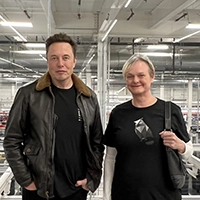Charging Electric Vehicles at Home
12/22/2023 / Gail Alfar
Charging your EV at home is game-changing. Imagine waking up every morning to a fully charged car, eliminating visits to gas stations and fluctuating fuel prices. In this article, we'll explore practical steps and tips for optimizing your home charging experience. We'll also look at some scientific facts to deepen our understanding.
Whether you drive a Tesla or any other EV, convenience and cost savings are universal.
Choosing the Right Wall Connector
Now, let's focus on some facts. Charging your electric vehicle at home is not just convenient; it's also energy-efficient. The typical energy efficiency of home chargers is around 85-90%, meaning you get a lot of bang for your buck in terms of energy consumption. Plus, home charging often has a lower carbon footprint than gasoline or public charging stations, contributing to reduced emissions.
Now, let's focus on some facts. Charging your electric vehicle at home is not just convenient; it's also energy-efficient. The typical charging efficiency of home chargers is around 85-90%, meaning you get a lot of bang for your buck in terms of energy consumption. Plus, the electricity used for home charging often has a lower carbon footprint compared to gasoline or public charging stations, contributing to reduced emissions.
Optimizing Charger Location
Your charger's location matters. A simple modification can make a difference. Many electricians install chargers at the back of the garage. For a small additional cost, consider running a conduit to the front of your garage. This simple adjustment means you won't have to back your car in every time you charge, making home charging incredibly convenient. It's these small changes that transform your daily routine.
Smart Charging Hacks
To get the most out of your home charging, there are some essentials to remember. Before embarking on a day trip, charge your EV to 100% the night before. This saves you time and effort but also money on the road. During your trip, remember that certain features like Sentry Mode and Cabin Overheat Protection can drain your battery. Consider opting out of these features when not necessary to maximize your range.
Additionally, let’s not forget a simple yet critical habit—plugging in your vehicle whenever you’re home. A happy electric vehicle is plugged in. It’s not about laziness; it’s about transitioning from the combustion vehicle era. Many of us are still getting used to home charging, and sometimes we forget. We’ve all been there. The key is to develop an effective routine, a habit that ensures your EV is ready whenever you need it. So, when you return home, plug in and ensure your electric vehicle is charged and ready for your next journey.
When you charge your EV at home, you're also contributing to grid stability. Home chargers can be programmed to draw electricity during off-peak hours, reducing the strain on the grid during peak demand. This saves you money but also ensures a more reliable and efficient electrical grid.
To optimize your home charging experience, we’ve shared essential tips, like charging your EV to 100% the night before a day trip to save time and money. But when it comes to daily driving, here’s a tip to keep your battery in prime condition: Charge it to about 80 to 90%. I’ll explain why.
Think of your electric vehicle’s battery as a friendly companion. It performs most effectively when it hovers around 80% to 90% unless the manufacturer specifically recommends otherwise. Maintaining an optimal battery charge level is vital for extending your battery's lifespan and caring for your battery's health is a breeze. In the Tesla app, you can effortlessly set your charge limit to 80% or 90%, eliminating frequent adjustments. When planning a day trip, a simple adjustment to 100% the night before ensures you have the power you need without hassle.
My Personal Experience
From personal experience, charging at home is a pleasure. It's like waking up to a full tank of gas every day but without fluctuating fuel prices. With electric vehicles, you know exactly what you're paying per kWh, thanks to your local utility. If you're fortunate enough to have solar panels or a battery Powerwall at your home, you might even be able to charge for free using excess electricity produced during the day.
The advantages extend beyond your EV. The ecosystem of solar panels, Powerwall, and EV is a step towards a cheaper and more sustainable future. The world is changing, and we're all getting better. When you drive an EV, whether you lease or buy one, you are part of the world’s exciting transition to sustainable energy.
My Thoughts
Charging your Tesla or other EV at home brings convenience and savings. Choosing the right wall connector, optimizing its location, and implementing smart charging hacks can make your daily routine hassle-free and cost-effective. With the shift towards EVs and sustainable energy, we're all contributing to a cleaner and brighter future.
Here’s a summary of my five favorite home-charging hacks:
Charge your EV to 100% the night before a day trip to save time and money.
Avoid regularly charging your EV to 100% for better battery health.
Select the right wall connector for your home and EV model.
Optimize the charger’s location for convenient daily use.
Consider charging during off-peak hours for cost savings.
Don’t forget to plug in your EV when you’re home.
Check out how you can lease your Tesla or other EV by contacting Xcelerate and start your journey to the clean and easy EV life.
Article by Gail Alfar for Xcelerate. Subscribe to Gail on 𝕏 at @GailAlfarATX or http://x.com/gailalfaratx
Posted in
Tagged



